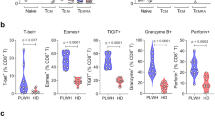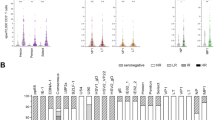Abstract
Reactivation of polyomavirus BK (BKV) infection represents a severe complication in kidney transplant (KTX) patients. We previously reported an association between a declining BK viral load and the reconstitution of CD4+ T cell BKV-specific immunity in patients following kidney transplantation. However, the specific contribution of CD4+ T cells in the regulation of BKV-replication is unknown. Nevertheless, in vitro enrichment of BKV-specific T cells and subsequent adoptive T cell transfer may improve the restoration of immune competence in KTX patients with BKV infection. To date, strategies to capture human BKV-specific T cells with the ensuing expansion to clinically useful numbers are lacking. Here, we demonstrated a comprehensive flow cytometric analysis of the BKV-specific T cell response that permits access to the majority of T cells specific for immunodominant BKV antigens. A full-spectrum evaluation of the BKV-specific T cell response was performed by stimulating peripheral blood mononuclear cells (PBMC) with a mixture of BKV immunodominant peptide pools at varying concentrations and measuring activation marker expression and cytokine secretion. We also examined the effects of co-stimulation and PBMC resting time prior to activation. We defined the narrow range of stimulation conditions that permit the capture and expansion of functional BKV-specific T cell lines. The generated BKV-specific T cell lines showed the highest specificity and functionality when the T cells were captured according to IFNγ-secretion. This study highlights the multifunctional and cytolytic BKV-specific CD4+ T cells as a dominant population within the generated T cell product. This method offers a novel approach for the generation of BKV-specific T cell lines for adoptive immunotherapy and underscores the critical role of CD4+ T cells in the clearance of BKV.






Similar content being viewed by others
Abbreviations
- BKV:
-
Polyomavirus BK
- BKV-PPM:
-
BKV overlapping peptide pool mix
- SOT:
-
Solid organ transplantation
- BKVAN:
-
BKV-associated nephropathy
- PBMC:
-
Peripheral blood mononuclear cells
- TCL:
-
T cell line
- SEB:
-
Staphylococcus enterotoxin B
- HAdV:
-
Human adenovirus
References
Knowles WA (2006) Discovery and epidemiology of the human polyomaviruses BK virus (BKV) and JC virus (JCV). Adv Exp Med Biol 577:19–45
Binet I et al (1999) Polyomavirus disease under new immunosuppressive drugs: a cause of renal graft dysfunction and graft loss. Transplantation 67(6):918–922
Hirsch HH (2002) Polyomavirus BK nephropathy: a (re-)emerging complication in renal transplantation. Am J Transplant 2(1):25–30
Hirsch HH et al (2002) Prospective study of polyomavirus type BK replication and nephropathy in renal-transplant recipients. N Engl J Med 347(7):488–496
Akazawa Y et al (2012) Fatal BK virus pneumonia following stem cell transplantation. Transpl Infect Dis 14(6):E142–E146
Breuer S et al (2012) Molecular diagnosis and management of viral infections in hematopoietic stem cell transplant recipients. Mol Diagn Ther 16(2):63–77
Bogdanovic G et al (2004) Association between a high BK virus load in urine samples of patients with graft-versus-host disease and development of hemorrhagic cystitis after hematopoietic stem cell transplantation. J Clin Microbiol 42(11):5394–5396
Babel N, Volk HD, Reinke P (2011) BK polyomavirus infection and nephropathy: the virus–immune system interplay. Nat Rev Nephrol 7(7):399–406
Bernhoff E et al (2008) Cidofovir inhibits polyomavirus BK replication in human renal tubular cells downstream of viral early gene expression. Am J Transplant 8(7):1413–1422
Hirsch HH, Steiger J (2003) Polyomavirus BK. Lancet Infect Dis 3(10):611–623
Ho ES et al (2000) Cytotoxicity of antiviral nucleotides adefovir and cidofovir is induced by the expression of human renal organic anion transporter 1. J Am Soc Nephrol 11(3):383–393
Ramos E et al (2009) The decade of polyomavirus BK-associated nephropathy: state of affairs. Transplantation 87(5):621–630
Mueller K et al (2011) BK-VP3 as a new target of cellular immunity in BK virus infection. Transplantation 91(1):100–107
Trydzenskaya H et al (2011) Novel approach for improved assessment of phenotypic and functional characteristics of BKV-specific T-cell immunity. Transplantation 92(11):1269–1277
Zhou W et al (2007) Functional characterization of BK virus-specific CD4+ T cells with cytotoxic potential in seropositive adults. Viral Immunol 20(3):379–388
Berger C et al (2008) Adoptive transfer of effector CD8+ T cells derived from central memory cells establishes persistent T cell memory in primates. J Clin Invest 118(1):294–305
Bleakley M, Turtle CJ, Riddell SR (2012) Augmentation of anti-tumor immunity by adoptive T-cell transfer after allogeneic hematopoietic stem cell transplantation. Expert Rev Hematol 5(4):409–425
Gerdemann U et al (2013) Safety and clinical efficacy of rapidly-generated trivirus-directed T cells as treatment for adenovirus, EBV, and CMV infections after allogeneic hematopoietic stem cell transplant. Mol Ther 21(11):2113–2121
Brestrich G et al (2009) Adoptive T-cell therapy of a lung transplanted patient with severe CMV disease and resistance to antiviral therapy. Am J Transplant 9(7):1679–1684
Mackinnon S et al (2008) Adoptive cellular therapy for cytomegalovirus infection following allogeneic stem cell transplantation using virus-specific T cells. Blood Cells Mol Dis 40(1):63–67
Peggs KS et al (2003) Adoptive cellular therapy for early cytomegalovirus infection after allogeneic stem-cell transplantation with virus-specific T-cell lines. Lancet 362(9393):1375–1377
Blyth E et al (2011) BK virus-specific T cells for use in cellular therapy show specificity to multiple antigens and polyfunctional cytokine responses. Transplantation 92(10):1077–1084
Comoli P et al (2003) Dendritic cells pulsed with polyomavirus BK antigen induce ex vivo polyoma BK virus-specific cytotoxic T-cell lines in seropositive healthy individuals and renal transplant recipients. J Am Soc Nephrol 14(12):3197–3204
Geyeregger R et al (2013) Short-term in vitro expansion improves monitoring and allows affordable generation of virus-specific T-cells against several viruses for a broad clinical application. PLoS One 8(4):e59592
Zandvliet ML et al (2011) Simultaneous isolation of CD8(+) and CD4(+) T cells specific for multiple viruses for broad antiviral immune reconstitution after allogeneic stem cell transplantation. J Immunother 34(3):307–319
Brestrich G et al (2009) Generation of HCMV-specific T-cell lines from seropositive solid-organ-transplant recipients for adoptive T-cell therapy. J Immunother 32(9):932–940
Rambal V et al (2014) Differential influenza H1N1-specific humoral and cellular response kinetics in kidney transplant patients. Med Microbiol Immunol 203(1):35–45
Wolfl M et al (2007) Activation-induced expression of CD137 permits detection, isolation, and expansion of the full repertoire of CD8+ T cells responding to antigen without requiring knowledge of epitope specificities. Blood 110(1):201–210
Frentsch M et al (2005) Direct access to CD4+ T cells specific for defined antigens according to CD154 expression. Nat Med 11(10):1118–1124
Zandvliet ML et al (2009) Detailed analysis of IFNg response upon activation permits efficient isolation of cytomegalovirus-specific CD8+ T cells for adoptive immunotherapy. J Immunother 32(5):513–523
Wehler TC et al (2008) Rapid identification and sorting of viable virus-reactive CD4(+) and CD8(+) T cells based on antigen-triggered CD137 expression. J Immunol Methods 339(1):23–37
Dong J et al (2007) IL-10 is excluded from the functional cytokine memory of human CD4+ memory T lymphocytes. J Immunol 179(4):2389–2396
Hoffmeister B et al (2003) Detection of antigen-specific T cells by cytokine flow cytometry: the use of whole blood may underestimate frequencies. Eur J Immunol 33(12):3484–3492
Schmueck M et al (2012) Preferential Expansion of human virus-specific multifunctional central memory T cells by partial targeting of the IL-2 receptor signaling pathway: the key role of CD4+ T cells. J Immunol 188(10):5189–5198
Hammer MH et al (2005) HLA type-independent generation of antigen-specific T cells for adoptive immunotherapy. Eur J Immunol 35(7):2250–2258
Hermans IF et al (2004) The VITAL assay: a versatile fluorometric technique for assessing CTL- and NKT-mediated cytotoxicity against multiple targets in vitro and in vivo. J Immunol Methods 285(1):25–40
Schachtner T et al (2011) BK virus-specific immunity kinetics: a predictor of recovery from polyomavirus BK-associated nephropathy. Am J Transplant 11(11):2443–2452
Dziubianau M et al (2013) TCR repertoire analysis by next generation sequencing allows complex differential diagnosis of T cell-related pathology. Am J Transplant 13(11):2842–2854
Kiecker F et al (2004) Analysis of antigen-specific T-cell responses with synthetic peptides—what kind of peptide for which purpose? Hum Immunol 65(5):523–536
Comoli P et al (2008) T-cell lines specific for peptides of adenovirus hexon protein and devoid of alloreactivity against recipient cells can be obtained from HLA-haploidentical donors. J Immunother 31(6):529–536
Lindqvist CA et al (2011) Both CD4+ FoxP3+ and CD4+ FoxP3− T cells from patients with B-cell malignancy express cytolytic markers and kill autologous leukaemic B cells in vitro. Immunology 133(3):296–306
Jagger AL et al (2012) FAS/FAS-L dependent killing of activated human monocytes and macrophages by CD4+CD25− responder T cells, but not CD4+CD25+ regulatory T cells. J Autoimmun 38(1):29–38
Ramaswami B et al (2011) The polyomavirus BK large T-antigen-derived peptide elicits an HLA-DR promiscuous and polyfunctional CD4+ T-cell response. Clin Vaccine Immunol 18(5):815–824
Jellison ER, Kim SK, Welsh RM (2005) Cutting edge: MHC class II-restricted killing in vivo during viral infection. J Immunol 174(2):614–618
Frentsch M et al (2013) CD40L expression permits CD8+ T cells to execute immunologic helper functions. Blood 122(3):405–412
Stark R et al (2013) IL-12-mediated STAT4 signaling and TCR signal strength cooperate in the induction of CD40L in human and mouse CD8+ T cells. Eur J Immunol 43(6):1511–1517
Romer PS et al (2011) Preculture of PBMCs at high cell density increases sensitivity of T-cell responses, revealing cytokine release by CD28 superagonist TGN1412. Blood 118(26):6772–6782
Rogers PR et al (2001) OX40 promotes Bcl-xL and Bcl-2 expression and is essential for long-term survival of CD4 T cells. Immunity 15(3):445–455
Qui HZ et al (2011) CD134 plus CD137 dual costimulation induces Eomesodermin in CD4 T cells to program cytotoxic Th1 differentiation. J Immunol 187(7):3555–3564
Monney L et al (2002) Th1-specific cell surface protein Tim-3 regulates macrophage activation and severity of an autoimmune disease. Nature 415(6871):536–541
Jelley-Gibbs DM et al (2005) Repeated stimulation of CD4 effector T cells can limit their protective function. J Exp Med 201(7):1101–1112
Sallusto F et al (1999) Pillars article: two subsets of memory T lymphocytes with distinct homing potentials and effector functions. Nature 401:708–712
Sallusto F et al (2014) Pillars article: two subsets of memory T lymphocytes with distinct homing potentials and effector functions. J Immunol 192(3):840–844
Fuller MJ et al (2004) Maintenance, loss, and resurgence of T cell responses during acute, protracted, and chronic viral infections. J Immunol 172(7):4204–4214
Schmueck M et al (2012) Preferential expansion of human virus-specific multifunctional central memory T cells by partial targeting of the IL-2 receptor signaling pathway: the key role of CD4+ T cells. J Immunol 188(10):5189–5198
Balduzzi A et al (2011) Polyomavirus JC-targeted T-cell therapy for progressive multiple leukoencephalopathy in a hematopoietic cell transplantation recipient. Bone Marrow Transplant 46(7):987–992
Feuchtinger T et al (2006) Safe adoptive transfer of virus-specific T-cell immunity for the treatment of systemic adenovirus infection after allogeneic stem cell transplantation. Br J Haematol 134(1):64–76
Acknowledgments
We thank Dr. Jason Millward for a critical reading and editing of the manuscript. The study was supported by Profit (EFRE grant) and Novartis grant to NB.
Conflict of interest
The authors have no conflicts of interest to disclose.
Author information
Authors and Affiliations
Corresponding author
Electronic supplementary material
Below is the link to the electronic supplementary material.
Rights and permissions
About this article
Cite this article
Weist, B.J.D., Schmueck, M., Fuehrer, H. et al. The role of CD4+ T cells in BKV-specific T cell immunity. Med Microbiol Immunol 203, 395–408 (2014). https://doi.org/10.1007/s00430-014-0348-z
Received:
Accepted:
Published:
Issue Date:
DOI: https://doi.org/10.1007/s00430-014-0348-z




